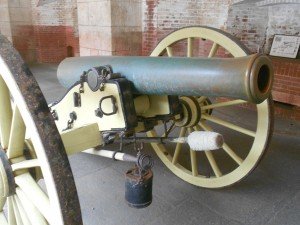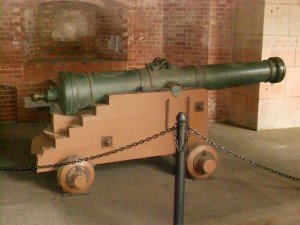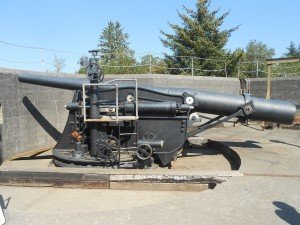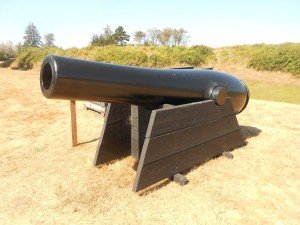During the 1800’s several forts built on the U.S. West Coast are now great sites to see the various types of military cannon exhibits once employed for protection. Two of these forts are popular tourist destinations and each is at the mouth of a major water inlet. One is Fort Point which has the distinction of now being located directly under the Golden Gate Bridge at the mouth of San Francisco Bay. Fort Point was put into service in 1861 and was built to hold 126 powerful cannons. Interestingly enough, Fort Point never had to fire a cannon during the Civil War. The other is Fort Stevens, located west of Astoria Oregon at the mouth of the Columbia River. In the case of Fort Stevens, it has the distinction of being fired upon by a Japanese submarine during World Wat Two. That certainly is unique history.
Thank you for reading this post, don't forget to subscribe!
The military cannon shown at left is a Napolean 12 Pounder 1857 Model on display at Fort Point in San Francisco. This piece was also a part of Civil War artillery. In fact, this was the most used smoothbore cannon during the American Civil War. The cannon was also referred to as the “light 12 pounder gun“.This cannon was obviously quite portable and was usually pulled by horse or mule. The gun was known for it’s power and reliability.

This next military cannon shown at right is the “San Martin” which was cast in Peru in 1684 and used by the Spanish military in California. This cannon was discovered by Captain John B. Montgomery in 1846 as it had been buried at the Presidio in San Francisco. Montgomery had taken over the fort which was then named “Castillo de San Joaquin” without a fight. The fort had been abandoned and was in disrepair as were it’s cannon. The Captain was able to put the cannon back in working order and along with two others brought down from Sonoma placed them in the new battery. This military cannon also on display at Fort Point has a Spanish crest engraved on the top on the rear third of the barrel.

The military cannon shown left is on display at Fort Stevens State Park, west of Astoria Oregon on the Pacific coast. The cannon can be seen at the Pratt Battery pointing out toward the Columbia River. The gun is a 75 MM M1897 artillery piece. Interestingly enough, this model gun had a life expectancy of about 10,000 rounds. This gun or more appropriately, cannon, weighs 16,216 pounds, fired a 104 pound projectile with a range of nine miles. Muzzle velocity was 2,600 feet per second using a 30 pound nitrocellulose powder charge. An interesting fact about the Japanese submarine shelling Fort Stevens during the war was that the shore batteries didn’t return fire. The story is that the post commander of Fort Stevens decided that returning fire during the midnight attack would only serve to give the submarine a better target. As it turned out, the Japanese shells were flying everywhere and the only official damage reported was to a baseball field backstop. While the attack was not significant in any way, it did liven things up at old Fort Stevens.

The cannon on the right is a replica 10 Inch Rodman Smooth Bore Model. It’s on display at Fort Stevens. This model cannon was reported to cost $1,795 in the year 1865. The cannons were made in 8 inch, 10 inch, 15 inch and 20 inch diameters. It took 20 pounds of gunpowder to fire a 125 pound projectile with a range of about three miles. Several of these can be found around coastal batteries in the San Francisco Bay Area as well. The gun weighs 15,400 lbs and was the most popular coastal cannon between the mid 1860’s to the 1890’s. The guns were so popular that many of the 10 inch models were later sleeved to 8 inches to help prolong their lifespan. The Rodman Guns were developed by Thomas J. Rodman who used a patented hollow core and water cooled method in their construction.

The small cannon shown at left is at Fort Point and is a Mortar Cannon. The Mortar Cannon essentially is made to fire low velocity projectiles over relatively short distances. This type of small muzzle loading cannon has been around for centuries, dating back to the 1400’s. Their small size can make them hard to aim especially if they are fired on unstable soil or snow. This particular mortar is a reproduction of a pre-Civil War mortar which was mounted on the tiers of seacoast forts. It is identical to weapons used in posts all around the San Francisco Bay area.
Links to two additional articles we’ve published that you’ll enjoy are the Mountain Howitzer and on our Western Trips site, 1800’s Frontier Firearms.
(Photos are from author’s private collection)
